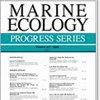Variation in top-down control of red algae epibiosis in the White Sea
IF 2.1
3区 环境科学与生态学
Q2 ECOLOGY
引用次数: 0
Abstract
ABSTRACT: Epibiosis is shaped by a complex interplay of biotic interactions involving hosts, epibionts, and mobile consumers. In temperate waters, consumer control by mesograzers prevents complete overgrowth of seaweeds. In polar waters, the mechanisms determining the abundances of sessile organisms associated with seaweeds are unknown. We empirically assessed the strength of the consumer control effect on the colonization of the sub-arctic red seaweed Phycodrys rubens by caging individual plants in the field in the shallow subtidal of the White Sea (65°N). We compared epibiosis on plants in consumer exclosure cages, in cages with the mesopredatory shrimp Spirontocaris phippsii, in semi-enclosed cages, and on unmanipulated plants in a cold year (2014) and a warm year (2015). Despite the dramatic interannual variation in consumer control, the mean total cover of epibionts in the absence of consumers never exceeded 15%. While consumers had a substantial effect on the total epibiont cover in the warm year and a nearly negligible effect in the cold year, the total cover of unmanipulated algae was similar in 2014 and 2015. Bryozoans, which were selectively impacted by consumers—particularly shrimp—dominated in both years. However, bryozoan abundance was much lower in 2015, when the abundance of hydroids, sponges, and bivalves—less affected by consumers—increased. Consumer control is not a key factor preventing most Phycodrys plants from being heavily overgrown. Yet, smaller plants, which have a higher epibiont cover, may indirectly benefit from consumers. Future climate changes are likely to make the Phycodrys epibiosis increasingly top-down regulated.白海红藻附生病自上而下控制的差异
摘要:寄生虫病是由寄主、寄生虫和移动消费者之间复杂的生物相互作用形成的。在温带水域,中生动物对消费者的控制阻止了海藻的完全过度生长。在极地水域,决定与海藻相关的无柄生物数量的机制尚不清楚。我们通过在白海(北纬 65°)浅潮下带的野外笼养单株海藻,对消费者控制对亚北极红海藻(Phycodrys rubens)定殖的影响强度进行了实证评估。我们比较了在寒冷年份(2014 年)和温暖年份(2015 年),在消费者封闭笼中、在有中食虾 Spirontocaris phippsii 的笼中、在半封闭笼中以及在未受操纵的植物上的附生虫病。尽管消费者控制的年际变化很大,但在没有消费者的情况下,附生虫的平均总覆盖率从未超过 15%。在暖年,消费者对附生藻类总覆盖率的影响很大,而在冷年,消费者对附生藻类总覆盖率的影响几乎可以忽略不计。受到消费者(尤其是虾类)选择性影响的浮游动物在这两年都占主导地位。然而,在 2015 年,受消费者影响较小的水螅、海绵和双壳贝类的丰度有所上升,因此岩绿藻的丰度要低得多。对消费者的控制并不是阻止大多数 Phycodrys 植物过度生长的关键因素。然而,附生植物覆盖率较高的小型植物可能会间接受益于消费者。未来的气候变化很可能会使 Phycodrys 附生植物的生长受到越来越多的自上而下的控制。
本文章由计算机程序翻译,如有差异,请以英文原文为准。
求助全文
约1分钟内获得全文
求助全文
来源期刊

Marine Ecology Progress Series
环境科学-海洋学
CiteScore
5.30
自引率
8.00%
发文量
238
审稿时长
3 months
期刊介绍:
The leading journal in its field, MEPS covers all aspects of marine ecology, fundamental and applied. Topics covered include microbiology, botany, zoology, ecosystem research, biological oceanography, ecological aspects of fisheries and aquaculture, pollution, environmental protection, conservation, and resource management.
 求助内容:
求助内容: 应助结果提醒方式:
应助结果提醒方式:


